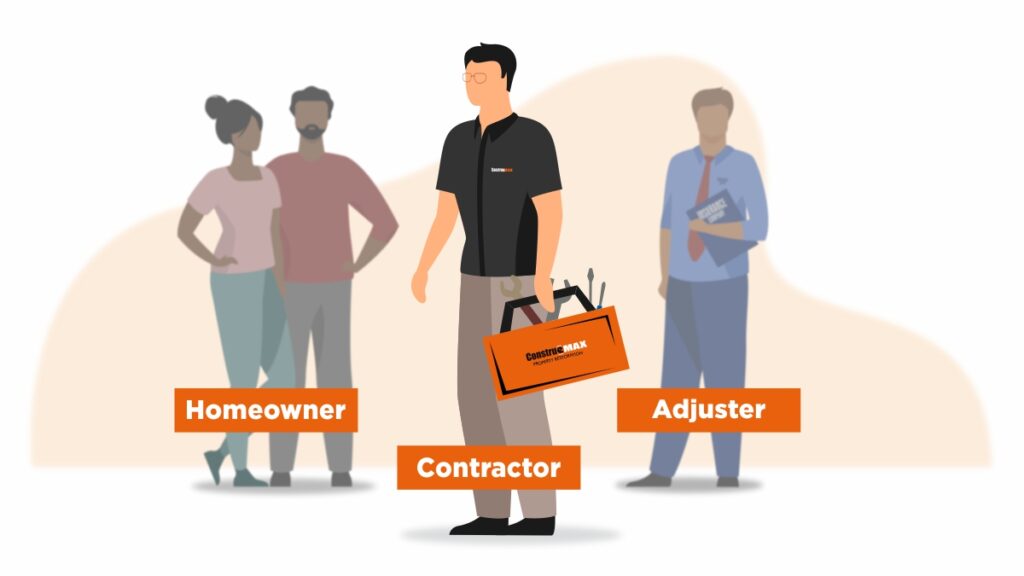Water Damage Series – Part 12: Your Contractor
The water mitigation contractor is the third member of your water loss recovery team.
First, we talked about the rights and responsibilities of the people who need things done: the property owner.
Then the people who make it possible to get it done by providing the money: the insurance company.
And now we talk about the people who get it done: the contractor.
Construemax is a contractor. It would be easy for me to say that this is the most important member of the team because without us, there is no recovery. But in truth, without the finances from the insurance company (or property owner when there is no insurance) the contractor can do nothing. Can’t buy materials and can’t hire labor.
But without permission from the property owner or guidance from the property owner, there is nothing for the contractor to do either.
The Recovery Team
If any member of this team is missing you have no recovery. So lets review the team again
1. The injured party (in our context the property owner)
2. The financially responsible party
3. The people performing the labor to restore the property
This time we’ll focus on the mitigation and restoration contractors. The people performing the labor to restore the property.

The People Doing the Work – Mitigation Contractor
The third member of your recovery team is the company you hire to do the work. Companies like Construemax specialize in disaster recovery and emergency services. We get training, stay on top of all of the latest techniques, use the best equipment, and spend our time focused on drying out homes, offices, and properties of every kind.

As you have surely observed throughout this water damage series, restorative drying is both an art and a science. It requires specialized tools and equipment to get it done efficiently and to arrest the damage quickly. Hiring a qualified specialist is the best way to meet your insurance company’s requirement to prevent further damage. In the case where you’re paying the bill, it will save you just as much expense as it would save the insurance company.
What We Are Not
While it’s important to identify the expertise that this member of the restoration team has, it is equally important to identify what the mitigation company and restoration contractor are not. We are NOT:
- Your insurance company
- Your public adjuster, lawyer, or any kind of representative
- A bank or financier of repairs
- County/city code inspectors
We are contractors hired by you to perform restorative drying and rebuild your property to pre-loss condition or better. Even if the insurance company recommends us or any other firm, the contractors work for YOU, not the insurance company.
What this means is that we can’t decide what will be covered by insurance and what will not. We can’t represent you or fight for you with the insurance adjuster. We will defend our estimates and the scope of work to live up to our high standards of quality, but we can’t make an adjuster agree with us. Likewise with the city and county inspectors.
But this also means that we don’t take orders from the adjuster or the bank. You hired us to do the job, and we work for your best interest. We will always comply with the city and county inspectors’ requirements to make sure your property is in compliance with government mandates.
Keep Things Moving
When the recovery process is halted, usually one member of the team could get it moving again. There are a number of things that can delay progress, and here are the things that commonly cause delays:
Property Owner
During the mitigation phase, the primary thing needed from the property owner is access. The property owner needs to grant the mitigation contractor written authorization to perform the work and access to the property. Every delay here can increase the amount of damage that needs to be addressed. Both authorization and access will be needed again during the reconstruction phase.
In the reconstruction phase, while the insurance company may be responsible for paying for repairs, there is always an insurance deductible that is required of the property owner. No work can begin until the first phase of the repairs project is funded. This means the property owner must pay the deductible. If the insurance company has paid the property owner already for the reconstruction, then 30 to 50% of the repairs estimate must be paid before the work begins.
The other thing that the property owner must do to limit delays is to provide the contractor all of their selections for materials. That means not only paint colors, but style of things like flooring, carpets, baseboards, etc. An indecisive property owner can delay a job considerably.
Insurance
Normally you can move quickly with the mitigation. Keep detailed records of the work and provide all of the receipts, the insurance company will take care of paying the bill.
When it comes to reconstruction, the insurance company is going to pay very close attention to what needs to be repaired. They will investigate what the costs of repairs should be and provide you a settlement offer based on this. It is not uncommon for there to be differences in opinions about what things will cost. As an example, the insurance company may offer a certain amount per square foot to replace the carpet. You may find that the amount offered will not cover the cost of the carpet you want. This disagreement, and many other possible points of disagreement, can cause delays in getting the reconstruction funded.
If an insurance company drags their feet in approving the contractor estimates, or negotiating with you on various points of the settlement, this can delay the reconstruction. Like the deductible issue above, no work can begin unless the contractor knows that he can complete the job, and the first phase of reconstruction is funded.
Contractor
During the mitigation phase, the contractor needs to have authorization from you, access to the property, and needs to have labor, supplies, and equipment available to do the job. Sometimes the contractor is very busy and can’t keep up with the demand, like after a major storm or hurricane. But when they tell you they are available, the only thing left they need is authorization from you and access to the property. The contractor takes care of the rest.

In the reconstruction phase, if your contractor has been funded with the first 30% – 50% of the repairs estimate, they can start the process of scheduling labor, ordering materials, and acquiring permits. The most common hold-ups in this phase, once the finances have been worked out with the insurance company, is the availability of labor, and the availability of materials. If material selection hasn’t been completed by the property owner, the job will be delayed.
After a hurricane especially, but also in some geographic locations or with some trades, labor can be short. It’s not uncommon to hear that someone had a roof ripped off during a hurricane and the property owner can’t get a roofer to repair it for 6 months. And then when the roofers are available, some roofing materials are unavailable because the selection made by the property owner is a popular color, style, or whatever. Whether with roofing or work inside the property, to get the work done faster, the property owner might be able to select different, more available materials.
Whenever there is a slowdown to your recovery process, look to your team to get the ball moving again.
Conclusion
Your recovery team will make all the difference for you. You are the leader of the team. You’ve hired an insurance company by purchasing
Hiring the contractor is where the rubber meets the road – so to speak. When a water disaster hits, the top priority is to arrest the progress of the damage. This means removing any standing water, removing any unsalvageable building materials, and drying out the affected area. Hiring a professional mitigation contractor to do that is your best course of action.
You rely on this time, but you need to hold the team accountable too. That means knowing your insurance policy, reading, understanding, and keeping records of all communications from them. It means requiring explanations of things you don’t understand. If necessary, you might need to hire representation. It means staying in contact with your contractors and holding them accountable for their work schedule.
This team means you’re not alone. The team will not always have the answers, but working together, they can help you find the answers. You are the team leader and you have the insurance company on the one side of you and the contractor on the other, both looking to the ultimate goal for you or complete recovery from your water damage disaster.









